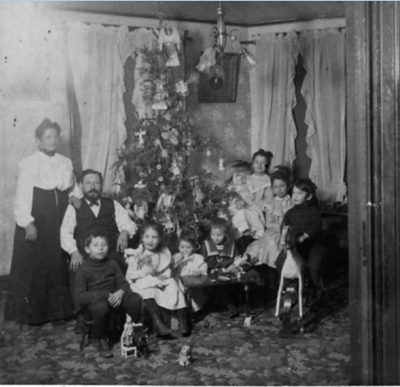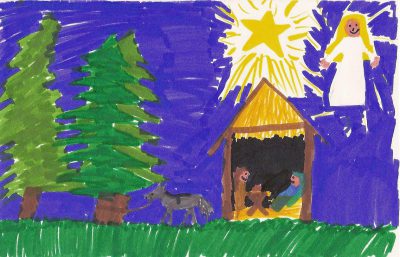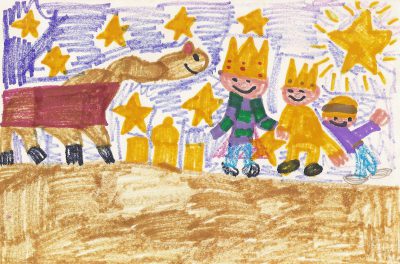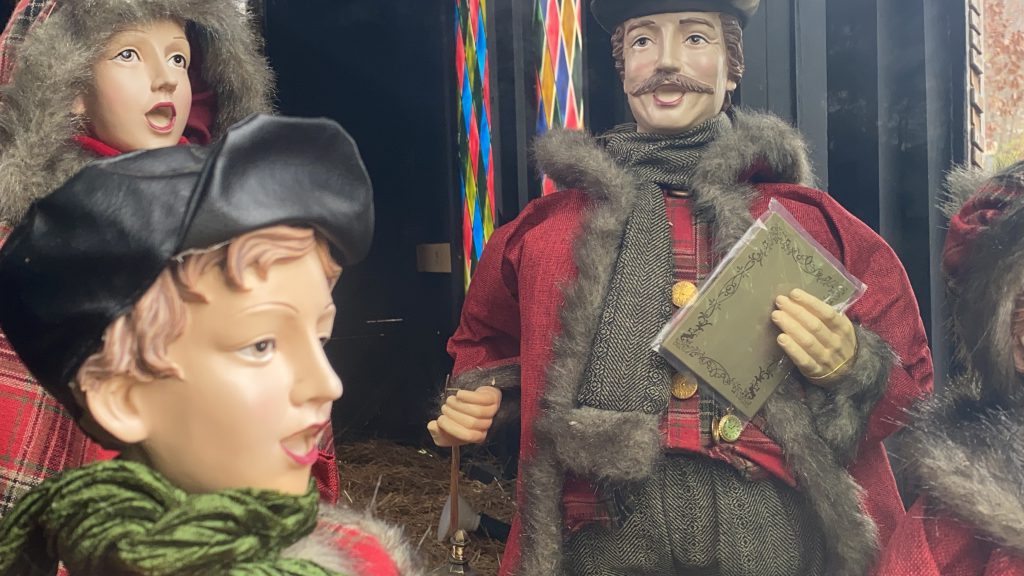Washington Co., WI – There is just something I love about Christmas. And what exactly is it? Well, let’s see…
I love bright red poinsettias and letters addressed to the North Pole with misspelled words and upside-down letters. And gingerbread men and velvet dresses. And staircase banisters decorated with yards and yards of fresh pine boughs.
Christmas, to me, means nutcracker soldiers and carolers. And paper chains, tinsel, mistletoe, and Yule logs. And driving through our neighborhood to look at lights. And standing in the middle of a local Christmas tree lot while breathing in deeply the first scent of evergreen.
Click HERE to SUBSCRIBE to FREE local news at
Washington County Insider on YouTube
What I love about Christmas is eating nutty fudge and pretzels dipped in white chocolate, and drinking punch on Christmas Eve, served in small crystal cups.
I love listening to Bing Crosby croon “White Christmas,” and hearing the Mormon Tabernacle Choir harmonizing to “Hark the Herald.”
What I love about Christmas is finding pretty cards inside colored envelopes in my mailbox during the season—and I even love the stamps.
Christmas, to me, is listening to a radio station that plays continuous holiday music, and it’s also waiting to hear the tinkle of a bell so that I may wonder if an angel got its wings.
What I love about Christmas is hearing Tiny Tim say “God bless us, everyone” at the end of “A Christmas Carol” as he is carried by Scrooge, and I even enjoy fruitcake. And eggnog. And frosted cookies with colored sugar sprinkles on them delivered in tin canisters.

What I love about Christmas is seeing children perform nativity pageants in homemade costumes crafted from bedsheets secured with safety pins and witnessing a living nativity.
Christmas is believing, along with Virginia, that there really is a Santa Claus.
It’s gathering with lifelong friends and toasting to, over the clink of glasses, the health and happiness of all.
There is just something about the season that makes my heart sing—like it does on Christmas morning when I look into the eyes of a child who has just spotted a teddy bear, a choo-choo train, or a talking dolly beneath the tree.

Christmas has come once again, and I will watch for elves peeking in through windowpanes because you just never know, and I will be reminded by George Bailey that it really is a wonderful life after all.
Soon, I will gather with those whom I love so much. I will open my arms wide, holding each of them longer and closer, near to my heart, because some of them have been away, but now they are home again because it is Christmas.
I love Christmas simply because I do, but I love it most because the holy night is approaching. My family and I will bundle ourselves on the sacred Eve and travel to the stone chapel in the country where my mother was baptized, and her mother. Before I enter the sanctuary, I will look into the night sky at the stars beneath the heavens, just as the wise men did so long ago, and I will wonder anew at what they saw there once upon a midnight clear. Then, steeple bells will ring, summoning all, and I will be among those who hear the old, old story read again by candlelight. I will close my eyes as I listen, pondering the words, and in those moments of holiness, I will believe, as I do every year, that the “peace on earth” printed in those Christmas cards back home is possible.
That, to me, is Christmas. And this: It is knowing that the best Christmas gifts in this world—love, peace, joy—don’t come from a store shelf. They can’t be bought. They are held in the heart, not in the hand.
Those gifts showed up on Christmas Eve 1914, in the middle of a war. Peace prevailed over the fighting during WWI when soldiers united themselves with their enemies on a field of battle. They sang Christmas carols together in multiple languages. They unwrapped parcels received from loved ones back home and shared the contents with their adversaries. They swapped cakes, liquors, plum puddings, and sausages as they celebrated a “silent night,” a “holy night,” together. Hearts were full of wonder at the outpouring of goodwill exchanged in No Man’s Land, a strip of earth—neutral ground—that was located in between the opposing trenches.

Eye-witness accounts survive in diaries, memoirs, archival newspapers, letters, and official war journals.
“Whatever the spirit of Christmas had been before that hour,” wrote Stephen Wunderli, “it was now, above all, the spirit of hope, of peace. And for a brief moment, the sound of peace was a carol every soul knew by heart.” He was awed, and he was not alone.
To many, the true story of what happened on that remarkable Christmas is called the “truce;” to many more, it is called the miracle. Heaven came near that year to a place that looked like hell. And it all began with the sight of an evergreen tree raised in honor of Christmas, lifted up in the midst of cannon roars. That tiny Tannenbaum was lit with real candles that were shining out from the darkness in commemoration of the Light of the World who was born nearly 2,000 years prior. Heaven used nature to usher in what would be called the “grand human moment” and “the most extraordinary event in world military history.”
Fatigued soldiers in 1914 were aching for home as Christmas approached. Who wouldn’t have been? The rapid conclusion to the conflict that had been expected didn’t happen. Instead of the war ending by Christmas, as was thought, the fighting widened.
The soldiers’ homesickness was companioned by actual sicknesses, caused by the less-than-sanitary living conditions the men were suffering through. Millions of soldiers—millions—perished because of diseases in the infested trenches, “graves for the living.” More men died as a result of the filth than the number of men who died from enemy fire—from bullets and bombs.
How then, in such a place, did something so utterly beautiful occur?
The serving soldiers who were there, those eyewitnesses, tell the story best of all, and can help us find an answer.
“Peace appeared from somewhere, I know not where,” wrote Ernie Williams. His sentiments were echoed by a private who was quoted in The Whitehaven News: “‘Peace on earth, goodwill toward men!’ It is hardly to be believed, but nevertheless, it is quite true that such was the case this Christmas. Who can realize it? It will astound everyone who hears about it, which everyone will do in good time.”
Piers Brendon believed the scene he looked upon on that noble night was simply “the most extraordinary celebration of Christmas since that notable goings-on in Bethlehem.”
“I was gazing toward the German lines and thinking to myself what a different sort of Christmas Eve this was from any I had experienced in the past,” wrote Graham Williams, “when suddenly lights began to appear along the top of the German trenches. These were Christmas trees adorned with lit candles, burning steadily. Other guards had, of course, seen the same thing, and quickly awoke those asleep in the shelters to ‘come and see this thing which had come to pass.’ Then suddenly our opponents began to sing ‘Stille Nacht, Heilige Nacht.’ They finished their carol, and then we sang ‘The First Noel.’ When we finished, they all began clapping. And so it went on. First, the Germans would sing one of their carols, and then we would sing one of ours, until we started up with ‘Oh, Come All Ye Faithful,’ and the Germans immediately joined in singing the same hymn to the Latin words ‘Adeste Fideles.’ And I thought, well, well, this is really a most extraordinary thing—two nations both singing the same carol in the middle of a war. And for an instant, the God of goodwill was once more master of this corner of the earth.”

Enemy soldiers stood side by side in kinship with their foes who became friends, even if only momentarily, and their words are an illumination of the benevolent gestures that unfolded on that blessed eve.
Carl Muhlegg, a private at Ypernbogen near Langemarck, remembered 50 years later: “I handed the captain the little Christmas tree. He lit the candles and wished his soldiers, the German nation, and the whole world ‘Peace according to the message from the angel.’”
Hugo Klemm remembered the too-good-to-be-true sight and noted: “As far as the eye could see lit Christmas trees were appearing to the right and left along the whole sector.”
Candles clamped to evergreen branches, flamed with a “glow of light falling everywhere.”
“It was a sight I shall never forget,” wrote Private W. Weir of the 18th Hussars. And from Gustav Riebensahm, a commander in the Westphalian Regiment came this memory: “One had to look again and again to believe what was happening.”
German leaders had transported Christmas trees by the thousands to the frontlines as gifts to their soldiers, hoping to bring them a little holiday cheer. These trees then became a key component in initiating the truce in many places. Troops watched in “fascinated excitement” as more and more candles were lit.
Soldiers from the 2nd Bedfordshires from Britain recalled a German who spoke fluent English coming across No Man’s Land in the darkness, shouting: “I am a lieutenant! Gentlemen, my life is in your hands, for I am out of my trench and walking toward you. Will one of your officers come out and meet me halfway? I am halfway across now, alone and unarmed. Gentlemen, I am waiting. Will not one of you come out and meet me?”
Those looking on from the trench opposite were baffled and bewildered at this soldier, fully exposed, who risked himself. They watched him increase his advance into the neutral ground. Rifles were readied. The target was sighted in. Then breaths were held. Everyone waited to see what would happen next. Silence followed. No attempt was made to gun that man down, and it soon became obvious to everyone’s eyes that peace—in a visible form—was on the move. It was a peace they could see with their eyes and hear with their hearts.
The stranger had shouted: “Come!” And thus bidden, they came.
“Scottish soldiers started playing their bagpipes,” recalled Sergeant-Major Frank Naden of the 6th Cheshires. Bugles were produced and “an orchestra” of horns and harmonicas, along with violins, accordions, and concertinas. Some men whistled and other men hummed during those rare moments, which were “so unpredictable and extraordinary,” when peace invaded a war.
The mixture of melodies, known since childhood, were sung, and thoughts headed homeward. Tensions eased. Soldiers started “swaying like rocking horses.” Who could fight with a song?
German soldiers greeted their French rivals with the words “Bonjour, messieurs,” as attempts were made to communicate in the other’s native tongue.
“What a sight! Groups of Germans and British extended almost the length of our front,” remembered Corporal John Ferguson, a Scotsman. “Where we couldn’t talk the language of the other, we were making ourselves understood by signs, and everyone seemed to be getting on nicely.”
Historians estimate that 100,000 soldiers participated in the truce in one way or another along the front during that advancing tide of brotherhood. News of the truce held headlines.
“We marched forward like Father Christmas with parcels hanging from us,” wrote Hugo Klemme. It was as if the soldiers forgot what they were supposed to be fighting for.
Instead of bracing themselves against an attack, they embraced their enemy; instead of shooting, they shook one another’s hand. The only thing shot during those memorable episodes were photos. Everyone was rounded up “like guests at a wedding” for group pictures.
Names and addresses were scribbled on bits of paper, and promises were made to write after the war ended.
Joint burial services were held in abandoned buildings near the frontlines later that Christmas night. “We fixed up a sort of makeshift altar in a barn,” remembered Robert de Wilde, a Belgian artillery officer.
Empty wine bottles served as candleholders for solemn services in those unlikely chapels where prayers ascended for those who were no more.
“Chaplain Adams arranged a reading of the 23rd Psalm,” recalled Arthur Pelham-Burn. “An interpreter wrote the words out in German. First, they were read in English by our padre, and then in German by a boy who was studying for the ministry. It was an extraordinary and most wonderful sight. The Germans formed up on one side, the English on the other.”
Letter writers who wrote home during the days following the truce used the word “holy,” in a shared feeling of awe, as if they knew, deep down, that God’s hand had been extended there as surely as their own on the Western Front in a place called “No Man’s Land,” which became Every Man’s Land that Christmas.
Merry Christmas! Frohe Weihnachten! Joyeux Noel! Vroliijk Kerstfeest!
About the author: ROCHELLE PENNINGTON is an award-winning newspaper columnist and bestselling author of ten books including Highlighted in Yellow (available in four languages; co-authored with H. Jackson Brown, #1 New York Times bestselling author), The Historic Christmas Tree Ship (as featured on national television), An Old-Fashioned Christmas (2009 Midwest Booksellers Choice Award nomination), and more. Her work has been included in multiple bestselling series over the past two decade.











